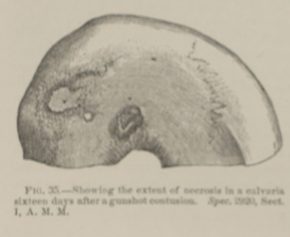Title: Kennedy, Thomas
Source text: Surgeon General Joseph K. Barnes, United States Army, The Medical and Surgical History of the War of the Rebellion. (1861–65.), Part 1, Volume 2 (Washington, D.C.: Government Printing Office, 1870), 111.
Civil War Washington ID: med.d1e7330
TEI/XML: med.d1e7330.xml
KENNEDY, THOMAS, Private, Co. M, 1st Massachusetts Heavy Artillery, aged 30, was wounded, at the battle of Petersburg, Virginia, June 16th, 1864, by a conoidal pistol ball, which contused the right parietal bone, near the right descending branch of the lambdoidal suture. He was conveyed to Washington, and admitted, on the 21st, into the Lincoln Hospital. Simple dressings were applied, as the injury was considered slight. He was furloughed on July 16th, but returned on the 29th of the same month. He stated that during his absence from the hospital he had suffered from ague, and, for the last ten days, had experienced a chill daily. A careful examination of the wound was now made, and a roughness of the external table of the skull was detected. He was much prostrated, but complained of no pain or uneasiness about the head. His pulse was frequent and feeble, tongue dry and red, and the abdomen tympanitic and painful. Three grains of calomel, with one-fourth of a grain of opium, were ordered every three hours, until the third dose had been taken; meantime, tonics and stimulants were given, and afterwards continued in liberal doses. Sinapisms were applied to the epigastric region and extremities. No perceptible improvement in his condition, however, was obtained. He died on the afternoon of the 31st, remaining fully sensible and able to answer questions intelligently until within two or three hours of his death. At the autopsy, the seat of injury was found to be near the middle of the posterior edge of the right parietal bone. The missile had glanced downward and forward, and was found lying against the skull, two inches from the point of injury. The pericranium was separated a distance of three and three-quarter inches along the track of the missile, and beneath it the bone was spongy and porous. The line of separation from healthy bone was well-marked. Upon the removal of the skull-cap, a slight sponginess of the internal table, beneath the point of impact, was observed. (See FIG. 35.) The meninges, for some distance around the seat of injury, were very much thickened and blackened, and firmly adherent to the calvaria. The brain substance was softened, and the vessels very much congested. The heart, liver, and spleen were flabby. The case is reported by Acting Assistant Surgeons Dean and Atwater.
 FIG. 35.—Showing the extent of necrosis in a calvaria sixteen days after a gunshot contusion. Spec. 2920,
Sect. I, A. M. M.
FIG. 35.—Showing the extent of necrosis in a calvaria sixteen days after a gunshot contusion. Spec. 2920,
Sect. I, A. M. M.